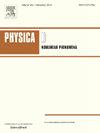基础设施扩建活动二氧化碳排放与控制的数学建模
IF 2.7
3区 数学
Q1 MATHEMATICS, APPLIED
引用次数: 0
摘要
大气中二氧化碳(CO2)浓度的上升导致全球平均地表温度升高。森林砍伐和基础设施扩张是导致二氧化碳浓度上升的主要原因。本研究提出了一个非线性数学模型,以探讨基础设施扩张对森林砍伐和大气二氧化碳浓度上升的影响。所提出的模型考虑了在人口增长的推动下基础设施活动的增长,这反过来又降低了森林生物量的承载能力。对模型进行了定性分析,以研究系统的长期行为。结果发现,基础设施扩张的高增长率会导致森林生物量平衡水平降低和二氧化碳浓度升高。此外,在基础设施扩张带动人口高速增长的情况下,基础设施增长率超过临界水平会导致系统失去稳定性,并通过超临界霍普夫分岔产生极限循环振荡。基础设施扩张活动和森林砍伐率导致的人口增长率系数增加,也会通过霍普夫分岔导致系统失去内部平衡的稳定性,并产生极限循环振荡。研究发现,当森林砍伐率极高时,系统可能会进入跨临界分岔,导致森林生物量灭绝。该研究通过将减缓方案的效率作为时间控制变量,以削减基础设施扩张导致的二氧化碳排放率和降低森林生物量承载能力的下降率,进而推导出有效利用现有减缓方案的策略,以减少基础设施扩张导致的二氧化碳排放。本文章由计算机程序翻译,如有差异,请以英文原文为准。
Mathematical modeling of emission and control of carbon dioxide from infrastructure expansion activities
The rise in atmospheric carbon dioxide () concentration has led to a rise in the global average surface temperatures. Deforestation and infrastructure expansion are key contributors to the increase in level. This study presents a non-linear mathematical model to explore the impact of infrastructure expansion on deforestation and rise in the atmospheric concentration. The proposed model considers the growth of infrastructure activities, driven by the increasing population, which in turn reduces the carrying capacity of forest biomass. The model is qualitatively analyzed to examine the system’s behavior in long run. It is found that a high growth rate of infrastructure expansion results in lower equilibrium level of forest biomass and higher concentrations. Moreover, for high population growth driven by infrastructure expansion, exceeding a critical level of infrastructure growth rate can cause the system to lose stability and generation of limit cycle oscillations through a supercritical Hopf-bifurcation. An increase in the growth rate coefficient of human population due to infrastructure expansion activities and deforestation rate can also lead to stability loss of interior equilibrium and existence of limit cycle oscillations in the system via Hopf-bifurcation. It is noticed that for critically high deforestation rate, the system may enter into transcritical bifurcation, resulting in the extinction of forest biomass. The study is extended to derive the strategies to effectively leverage existing mitigation options to reduce emissions from infrastructure expansion by taking efficiencies of mitigation options to cut the carbon dioxide emission rate and reduce the declination rate of carrying capacity of forest biomass resulting from infrastructure expansion as time-dependent control variables.
求助全文
通过发布文献求助,成功后即可免费获取论文全文。
去求助
来源期刊

Physica D: Nonlinear Phenomena
物理-物理:数学物理
CiteScore
7.30
自引率
7.50%
发文量
213
审稿时长
65 days
期刊介绍:
Physica D (Nonlinear Phenomena) publishes research and review articles reporting on experimental and theoretical works, techniques and ideas that advance the understanding of nonlinear phenomena. Topics encompass wave motion in physical, chemical and biological systems; physical or biological phenomena governed by nonlinear field equations, including hydrodynamics and turbulence; pattern formation and cooperative phenomena; instability, bifurcations, chaos, and space-time disorder; integrable/Hamiltonian systems; asymptotic analysis and, more generally, mathematical methods for nonlinear systems.
 求助内容:
求助内容: 应助结果提醒方式:
应助结果提醒方式:


